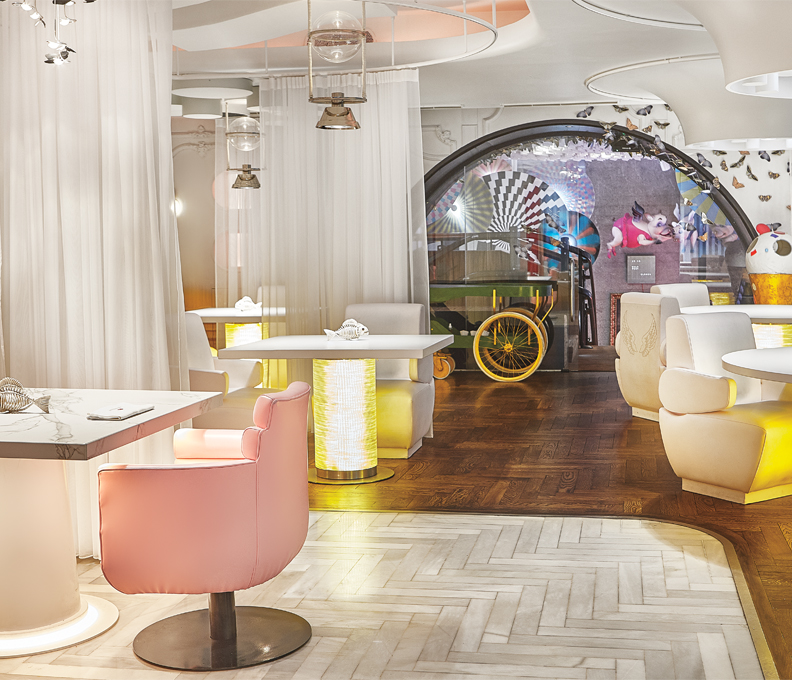A new side to Sydney
December 30, 2016

Sydney has added two new areas to its already formidable range of lifestyle developments, both within easy reach of the Central Business District.
In years to come, Barangaroo, located behind the Harbour Bridge, is almost certain to be part of any business-related itinerary, given that the ambitious and expansive complex is targeted at the corporate world, with gleaming office towers and, by year-end, a range of upscale restaurants. A casino-resort is also planned for the gigantic site, which features parkland, walkways, fast-food outlets and coffee shops.
Chippendale Creative Precinct is a rather less grandiose project – more a gentrification of a once-seedy suburb at the top of the main George Street thoroughfare. It now hosts art galleries, boutiques, noodle bars and gourmet restaurants, including the Kensington Street Social, operated by star UK chef Jason Atherton. Take a wander through either district if you get some time between meetings.
Barangaroo
The developers of Barangaroo (barangaroo.com) clearly have deep pockets – illustrated by their decision to trumpet their food and beverage aspirations by hosting a pop-up of the world’s best restaurant, Noma, in February and March this year.
Even before the first dish was served, it had generated a huge buzz in Australia, with 27,000 people on the waiting list for a table at the oceanside venue. Danish chef René Redzepi spent months scouring the country for ingredients before creating a menu that included seafood paired with wattle seed, lantana flowers and crocodile fat. It was meant to send the message to Sydneysiders – and the world at large – that Barangaroo was aiming high by offering a formidable range of gourmet options. The space where Noma operated will, in time, be occupied by the popular Aussie culinary duo of Brent Savage and Nick Hildebrandt, who also run the Bentley, Monopole and Yellow restaurants in the city.
The first fully-fledged restaurant to open was Anason (anason.?com.au), featuring Turkish cuisine based on the meyhanes (taverns) of Istanbul. It is right on the waterfront, as are a whole slew of other restaurants scheduled to open later this year. These include Lotus, serving Chinese-style dumplings; Banksii, a bar and bistro with a Mediterranean theme; Tapa Vino, offering sherry, wine and food; and Zushi, a yakatori bar serving a range of sake. As of now, you can pop into the high-end food court Canteen, choose from a wide selection of coffee shops, or pay a visit to the Barber Shop (thisisthebarbershop.com), which offers haircuts accompanied by a “wee dram” of whisky from the in-house bar.
On the fringes of Barangaroo is Beer Deluxe (kingstreetwharf.com.?au), which offers a tempting range of 20 beers on tap and a total of 150 different brews – reaffirming that Australia has come a long way from the days where drinkers were offered the uninspired choice of ice-cold draught Foster’s, ice-cold draught Tooheys or ice-cold draught Carlton.
There will be plenty of thirsty after-work customers from the Barangaroo complex in the years to come – developers estimate that when it reaches capacity, about 23,000 office workers will have International Towers Sydney on their business cards. Towers Two and Three are operational, with a combined 11,000 workers, a figure that will rise to 17,000 when Tower One opens before the end of the year.
Still, Barangaroo – it takes its name from a formidable 18th-century female Aboriginal leader – has been dogged by controversy ever since plans were announced to redevelop the former container wharf, which is a 15-minute harbor-hugging walk from the Circular Quay ferry terminal. The thrust of the criticism is that the footprint, and scale, of the AU$6 billion project has crept beyond the planning permission.
It is certainly big, covering 54 acres in total. As well as the three commercial blocks, there is a mile-long harborside walkway, along with a 14-acre park – Barangaroo Reserve – that sits right on the headland offering views of the Harbour Bridge, along with cycling and walking trails, and foliage that will include 75,000 native trees and shrubs. A new ferry pier is due to open early next year.
Chippendale Creative Precinct
The area of Chippendale was unlikely to ring many bells until recently, even with people who have a decent knowledge of Australia’s largest city. But what a difference a few years makes. The former rundown neighborhood – now the Chippendale Creative Precinct (chippendalecreative.com) – has become one of the city’s most vibrant enclaves with funky restaurants, lively bars, trendy boutiques and carefully curated art galleries, many housed in restored factories and warehouses.
The dynamic force behind its transformation and gentrification was gallery owner Nicky Ginsberg, who saw the potential for it to become a creative hub and campaigned successfully for funding from public and private sources. It has a restaurant by Michelin-starred chef Jason Atherton, whose innovative food can be found at the Kensington Street Social (kensingtonstreetsocial.com) in the Old Clare hotel (theoldclarehotel.com.au).
Named after the Irish owner’s native county of Kensington, and open since last September, the 62-room boutique property is a renovation of two heritage buildings – the Clare Hotel pub and a Carlton and United Breweries administration building – and is a Design Hotels member.
“Before joining last year, I hadn’t heard of Chippendale, or the Kensington Street precinct,” says Kensington Street Social’s general manager, Michael Gavaghan. “Ten months later, Kensington Street is becoming one of Sydney’s top dining destinations with a wide selection of new eateries and bars showcasing street food, fine dining and more casual shared experiences.”
The Kensington Street Social menu is described as British-Mediterranean, with plates made for sharing. Among the star dishes is “tea and toast” – wild mushroom tea served in a teapot, with relish-and-bone-marrow toast. Other specialties include marinated salmon, sea urchin risotto, Moreton Bay bug tail lobster and Bolivian chocolate soufflé with macadamia nut ice cream.
The neighboring Automata (automata.com.au) has a distinctive design, as well as a captivating five-course tasting menu that changes regularly. A third high-end restaurant in the hotel building, Silvereye (silvereye-restaurant.com.au), is presided over by former Noma executive chef Sam Miller, who focuses on preparing Australian vegetables and herbs in innovative ways. Tasting menus of three, seven or 11 courses are on offer.
If fine dining does not appeal to you, there are a number of smaller noodle shops, burger joints and bistros to choose from. Try Din Tai Fung (dintaifung.com.au) for some of the world’s finest Chinese-style dumplings; consistency is the key to the Taiwanese-based chain’s success, with a devoted following in Hong Kong, Shanghai and Beijing.
Dotted around the precinct are up to 20 galleries, located either in the low-rise brick-built street buildings or the more spacious confines of the adjoining Central Park mall (centralparksydney.com). UTS gallery (art.uts.edu.au/gallery) showcases contemporary art, as does Ambush (ambushgallery.com). White Rabbit Gallery (whiterabbitcollection.org) has artworks from China spread over four floors of an old factory. Long before gentrification began in the area, the Harrington Street Artists Co-operative Gallery (harrington streetgallery.com) was founded by artist John Ogburn as a showcase for emerging talents.
The addition of more and more galleries doubtless benefits all artists, as thousands of potential buyers – from Sydney and further afield – head to the area daily to browse and buy, soak up the bohemian atmosphere and round off the day with a meal, or cocktails in the lively bar of the Old Clare hotel.
By Mark Graham



